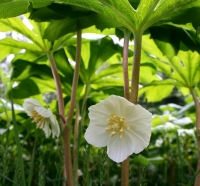Paths are wheelchair accessible, “imaginature” stations provide places for children to climb and crawl and the ecosystem design is sure to interest the novice and the expert naturalist. There will also be a new trail to explore connecting the Oak Leaf Trail to the southern edge of the Arboretum along North Avenue.
Here are a few things to watch for:
Spring flowers:
Thousands of wildflowers have been planted throughout the arboretum and this season will begin to reveal the benefits of that great undertaking. For example, look for both rare and common species of showy three-leaved trilliums. More humorously named flowers such as Jack-in-the-pulpit and Dutchman’s-breeches have spring flowers named for their unique look. The spotted leaves of the Trout lily provide a backdrop for this more common but beautiful white flower. Large leaves of the May apple (pictured above) look like giant umbrellas, each shielding its flower. Sickle pod, Blue cohosh, Ladies slippers, Coreopsis and many more wildflowers are showing their colors this spring.
Cairns:
For those of you who have hiked in the western United States, some eastern states and even internationally, you may have seen trails marked by cairns: a small pile of rocks, clearly arranged by a person. A well laid out trail will have just enough cairns so that just as you think you might be about to stray from the trail, another will appear, giving both a sense of adventure and confidence. Inspired by the interaction many of the Center’s staff and friends have enjoyed while following cairns, the Arboretum’s cairns will mark the many entrances to this newly revitalized recreational area. You will be able to watch as these larger-than-life, some even bigger than a person, cairns are constructed on the property near the Arboretum’s parking lot. The boulders that are being used are native to Wisconsin and like a traditional cairn, they will mark the trails so that you will know when you are entering or exiting the Arboretum.
Tours:
Did you know that 49 trained volunteer docents are ready to give tours of the Milwaukee Rotary Centennial Arboretum? On a tour, you will discover what makes this arboretum unique and discover the vast array of people who today and throughout history have interacted with this beautiful land in the heart of our city. In addition, you’ll meet wonderful people who are excited to explore with you and share what they’ve learned. Or, to discover hundreds of migratory and resident birds found here, you can join a Thursday morning bird walk or any of the birding workshops.
You can join one of our public tours, or give us a call for a private tour. With a few weeks’ notice, we can schedule a tour to fit the schedule for your family, work colleagues, clubs, churches and more.
Want to learn more about what’s happening, share an idea or meet others interested in this space? Please come to our Riverside Update and Community Forum on May 6th (see details on page 7), where you will learn more about the happenings at Riverside Park and will help shape the future activities of our Center.
If you haven’t visited the Arboretum, or even if you’ve been here many times before, we invite you to watch our first spring as it unfolds. Take a docent tour, participate in a program, dig in the dirt as a volunteer and explore this ever-evolving landscape.





